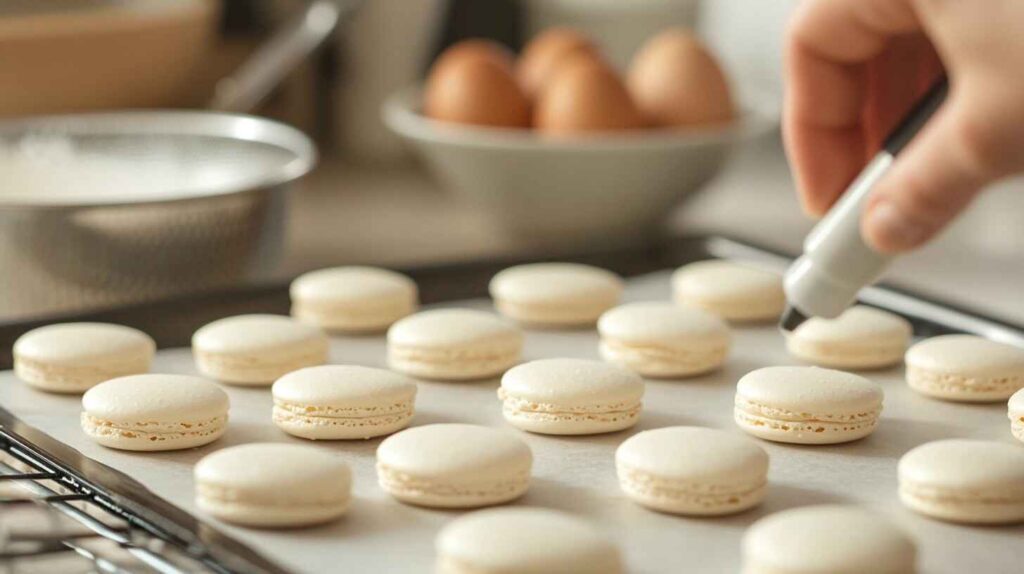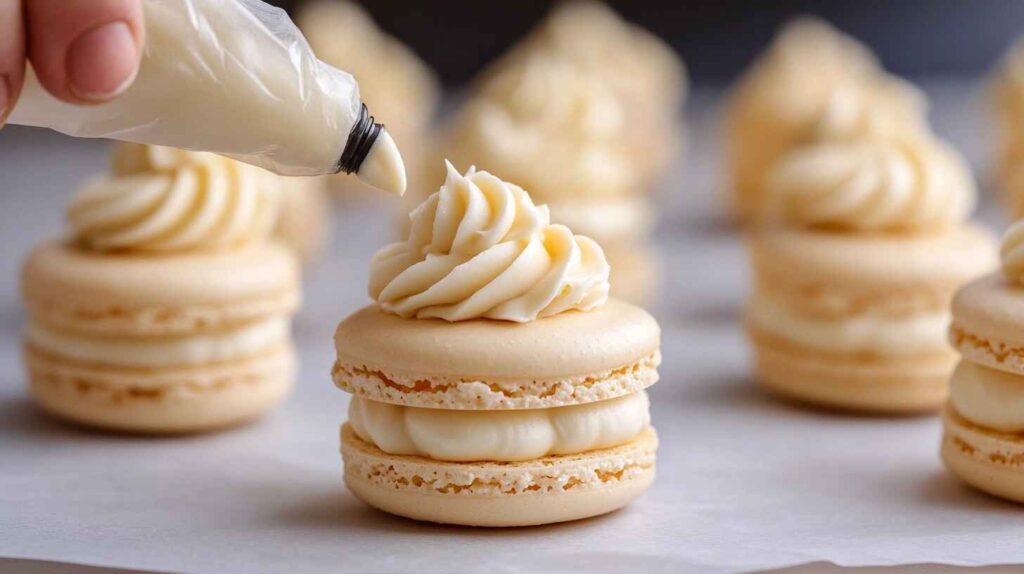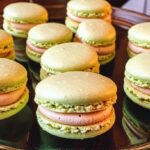Macarons—those dainty, pastel-colored treats you see in fancy bakeries—aren’t just desserts; they’re a work of art. These delicate cookies, made from almond flour and filled with luxurious French buttercream, have captivated pastry lovers worldwide. But let’s be honest—making them at home can feel like a battle against the laws of baking physics.
If you’ve ever attempted macarons and ended up with cracked shells, hollow centers, or runny buttercream, you’re not alone. The good news? You’re about to master French buttercream macarons the right way. This guide will walk you through everything—ingredients, step-by-step recipes, troubleshooting, and expert tips—so you can bake like a pro.
Table of Contents
“Macarons are a test of patience and precision, but with the right technique, anyone can achieve bakery-quality results.”
What Are French Buttercream Macarons?
Before diving into the details, let’s clarify what makes these macarons different from other types. The shell remains the same—light, crisp, and slightly chewy. The magic happens in the filling. Instead of the typical ganache or Swiss meringue buttercream, French buttercream is used, resulting in a rich, silky texture that melts in your mouth.
A Brief History of Macarons
Macarons trace their origins to Italy, introduced to France in the 16th century by Catherine de’ Medici’s pastry chefs. However, the modern double-decker macaron—two shells with a creamy filling—was popularized by the French pâtisserie Ladurée in the 20th century. Today, macarons are a symbol of French pastry excellence, requiring skill and precision to perfect.
Why French Buttercream Instead of Other Fillings?
French buttercream stands out from other buttercreams because of its ultra-smooth texture and deep, buttery flavor. Unlike Swiss or Italian buttercream, which are made with egg whites, French buttercream uses egg yolks, giving it a richer and more luxurious taste.
Key Ingredients for French Buttercream Macarons
The right ingredients make all the difference. Below is a table outlining what you’ll need for both the macaron shells and the French buttercream filling.
| Ingredient | Quantity | Purpose |
|---|---|---|
| Almond flour | 100g (1 cup) | Gives the macaron its signature texture |
| Powdered sugar | 100g (1 cup) | Sweetens and softens the shell |
| Egg whites (aged) | 2 large (60g) | Creates the meringue structure |
| Granulated sugar | 50g (¼ cup) | Stabilizes the meringue |
| Butter (unsalted, softened) | 150g (2/3 cup) | Main ingredient in French buttercream |
| Egg yolks | 3 large | Creates the silky French buttercream texture |
| Granulated sugar (for syrup) | 100g (½ cup) | Sweetens the buttercream |
| Water | 2 tbsp | For making sugar syrup |
| Vanilla extract | 1 tsp | For flavor |
Step-by-Step Recipe for Perfect French Buttercream Macarons

Let’s break the process down into two parts: making the macaron shells and preparing the French buttercream filling.
Step 1: Preparing the Macaron Shells
- Prepare your ingredients: Sift almond flour and powdered sugar together into a bowl to remove any lumps.
- Make the meringue: Beat the egg whites on medium speed until foamy. Gradually add granulated sugar, increasing to high speed, until you reach stiff peaks.
- Macaronage: Gently fold the almond flour mixture into the meringue. The batter should flow like lava—thick but spreadable.
- Pipe the shells: Transfer the batter to a piping bag and pipe small circles onto a baking sheet lined with parchment paper.
- Resting time: Let the shells sit at room temperature for about 30-45 minutes until they form a slight skin.
- Bake: Preheat the oven to 300°F (150°C) and bake for 12-15 minutes. Let them cool before removing from the tray.
Step 2: Making the French Buttercream
- Make the sugar syrup: Heat sugar and water in a small saucepan until it reaches 240°F (115°C).
- Whip egg yolks: While the syrup is heating, beat the egg yolks until pale and fluffy.
- Combine: Slowly pour the hot syrup into the beaten yolks while mixing on low speed. Continue beating until the mixture cools.
- Add butter: Gradually add softened butter, one piece at a time, and beat until smooth and fluffy.
- Flavor: Add vanilla extract and beat for another 30 seconds.
Step 3: Assembling and Maturing the Macarons
- Match up macaron shells of similar sizes.
- Pipe a generous amount of buttercream onto one shell and gently press the second shell on top.
- Refrigerate for 24 hours before eating—this allows the flavors to develop fully.
Common Problems & Solutions When Making French Buttercream Macarons
Even experienced bakers face macaron challenges. Here are some common issues and how to fix them.
| Problem | Cause | Solution |
|---|---|---|
| Hollow shells | Overmixed batter or too high baking temperature | Mix until the batter flows like lava; lower the oven temperature |
| Cracked shells | Shells didn’t rest long enough | Allow shells to develop a skin before baking |
| Buttercream too runny | Butter was too warm or eggs weren’t whipped enough | Chill the buttercream for 15 minutes before piping |
| Macarons sticking to parchment | Undercooked shells | Bake for an extra 1-2 minutes |
Coming Next: Mastering Expert Tips & Flavor Variations
Now that you’ve learned how to make these delicious macarons, stay tuned for the second part, where we’ll cover expert tips, flavor variations, and long-term storage solutions.
Expert Tips for Mastering French Buttercream Macarons
Macarons can be tricky, but these expert tips will help you achieve perfection every time.
1. Achieving the Perfect “Feet” on Macarons
The signature **ruffled edge**, or “feet,” is a sign of well-made macarons. If yours aren’t developing, try these solutions:
- Let the piped macarons rest for at least 30-45 minutes before baking.
- Ensure your oven temperature is accurate (an external thermometer helps).
- Use aged egg whites to create a more stable meringue.
2. Best Tools and Equipment for Professional-Looking Macarons
Having the right tools makes a difference. Here’s what you need:
- Kitchen scale – Macarons require precise measurements.
- Fine mesh sieve – Helps sift almond flour and powdered sugar.
- Silicone baking mat – More reliable than parchment paper.
- Oven thermometer – Ensures accurate baking temperatures.
3. The Role of Temperature and Humidity in Baking
Macarons are sensitive to humidity. If it’s too humid:
- Use a dehumidifier in your kitchen.
- Let macarons rest longer before baking.
- Increase oven temperature slightly to help drying.
“The secret to perfect macarons is patience and precision. Don’t rush the process, and you’ll be rewarded with bakery-worthy treats!”
Flavor Variations for French Buttercream Macarons

Want to switch things up? Try these delicious variations!
1. Classic Vanilla Bean Macarons
- Add 1 teaspoon of vanilla bean paste to the buttercream.
- Pair with lightly colored macaron shells for a simple, elegant treat.
2. Decadent Chocolate French Buttercream Macarons
- Add 2 tablespoons of melted dark chocolate to the buttercream.
- Use cocoa powder in the macaron shells for a rich chocolate experience.
3. Fruity Variations: Raspberry, Lemon, and More
- Mix 2 tablespoons of fruit puree (strawberry, raspberry, or mango) into the buttercream.
- Pair with colored shells for a visually appealing dessert.
How to Store and Preserve French Buttercream Macarons
Macarons taste best after 24 hours of “maturing” in the fridge, but proper storage is key.
Storing at Room Temperature vs. Refrigeration
- Macarons can be kept at room temperature in an airtight container for up to 2 days.
- For longer storage, refrigerate them for up to **one week**, ensuring they’re in a sealed container.
Can You Freeze French Buttercream Macarons?
- Yes! Store macarons in an airtight container and freeze for up to **3 months**.
- To thaw, let them sit at room temperature for **30 minutes** before serving.
Frequently Asked Questions (FAQs) About French Buttercream Macarons
1. Why Did My Macarons Crack in the Oven?
Cracking is usually due to:
Skipping the resting step (allow the skin to form before baking).
Baking at too high a temperature.
Overbeating or undermixing the batter.
2. How Do I Fix Runny French Buttercream?
If your buttercream is too thin, try:
Refrigerating it for 10-15 minutes before rewhipping.
Adding a tablespoon of powdered sugar to help stabilize.
Ensuring the butter isn’t too warm when mixing.
3. Can I Make Macarons Without Almond Flour?
Macarons rely on almond flour for their texture, but you can substitute **finely ground sunflower seeds** for a nut-free version.
4. What’s the Best Way to Color Macarons?
Use gel food coloring instead of liquid to avoid changing batter consistency.
Fold the color in carefully to prevent overmixing.
Conclusion: Elevate Your Macaron Game with the Perfect French Buttercream
French buttercream macarons may seem intimidating, but with **patience, precision, and practice**, you’ll be making bakery-quality treats in no time! Remember:
- Use aged egg whites for stable meringue.
- Let the shells rest before baking to develop feet.
- Master French buttercream for a smooth, luxurious filling.
Now it’s time to grab your ingredients and start baking. Your **perfect batch of macarons** is just one step away!
“Baking is a science, but macarons are an art. Master both, and you’ll create magic in the kitchen!”

The Best French Buttercream Macarons: Troubleshooting & Expert Tips
- Total Time: 2 hours (including resting)
- Yield: 12–15 macarons 1x
- Diet: Vegetarian
Description
These French Buttercream Macarons are a true indulgence, featuring crispy-yet-chewy almond shells filled with a silky, custard-like buttercream. Perfect for special occasions or as a gourmet treat, this recipe ensures bakery-quality results with step-by-step guidance and troubleshooting tips. Whether you’re a beginner or an experienced baker, these macarons will become your go-to recipe!
Ingredients
For the Macaron Shells:
- 100g (1 cup) almond flour (finely ground, sifted)
- 100g (1 cup) powdered sugar
- 60g (2 large) egg whites (aged for 24 hours at room temp)
- 50g (¼ cup) granulated sugar
- ½ tsp vanilla extract (optional)
- Gel food coloring (optional, avoid liquid-based colors)
For the French Buttercream Filling:
- 3 large egg yolks
- 100g (½ cup) granulated sugar
- 2 tbsp water
- 150g (⅔ cup) unsalted butter (softened)
- 1 tsp vanilla extract or other flavoring
Instructions
Step 1: Prepare the Macaron Shells
- Sift Dry Ingredients – In a bowl, sift almond flour and powdered sugar together to remove lumps. Set aside.
- Make the Meringue – In a clean, dry bowl, beat egg whites until foamy. Gradually add granulated sugar and continue beating until stiff peaks form.
- Macaronage (Folding Process) – Gently fold the sifted almond flour mixture into the meringue, mixing until the batter flows like lava and forms a ribbon when lifted.
- Pipe the Macarons – Transfer the batter to a piping bag fitted with a round tip and pipe small circles onto a parchment-lined baking sheet. Tap the tray on the counter to remove air bubbles.
- Rest the Shells – Let the piped macarons sit at room temperature for 30-45 minutes until a skin forms on top.
- Bake – Preheat the oven to 300°F (150°C) and bake for 12-15 minutes until the shells are set and have developed “feet.” Let them cool completely before filling.
Step 2: Make the French Buttercream
- Prepare Sugar Syrup – In a small saucepan, heat sugar and water to 240°F (115°C) until it forms a syrup.
- Whip Egg Yolks – While the syrup is heating, beat the egg yolks in a bowl until pale and fluffy.
- Combine – Slowly pour the hot sugar syrup into the yolks while mixing on low speed. Increase speed and whip until cooled.
- Add Butter – Gradually add softened butter and continue whipping until smooth and fluffy. Stir in vanilla extract.
Step 3: Assemble the Macarons
- Match Shells – Pair up macaron shells of similar sizes.
- Pipe Buttercream – Transfer the French buttercream to a piping bag and pipe a generous amount onto one shell.
- Sandwich & Mature – Gently press the second shell on top and refrigerate for 24 hours to develop flavors.
Notes
- Aging egg whites for 24 hours creates a more stable meringue.
- Resting time before baking is crucial to prevent cracking.
- French buttercream is softer than other buttercreams, so refrigerate slightly before piping if needed.
- Macarons taste better after 24 hours as the filling softens the shells for the perfect bite.
- Prep Time: 30 minutes
- Cook Time: 15 minutes
- Category: Dessert
- Method: Baking
- Cuisine: French
Nutrition
- Serving Size: 1 macaron
- Calories: ~120 kcal
- Sugar: ~10g
- Sodium: ~10mg
- Fat: ~6g
- Saturated Fat: ~3g
- Unsaturated Fat: ~3g
- Trans Fat: 0g
- Carbohydrates: ~15g
- Fiber: ~1g
- Protein: ~2g
- Cholesterol: ~35mg







